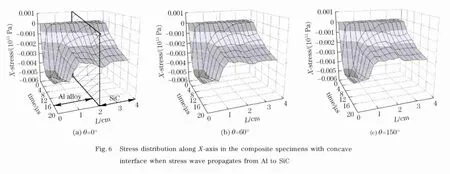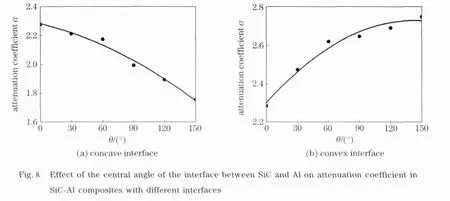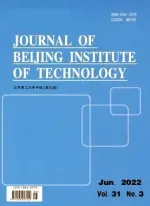Numerical simulations of stress wavepropagation and attenuation at arc-shaped interface inlayered SiC/Al composite
SUN Ming-yan(孙明燕), ZHANG Zhao-hui(张朝晖),2, YANG Rui(杨瑞),WANG Fu-chi(王富耻),2, LI Shu-kui(李树奎),2
(1.School of Materials Science and Engineering,Beijing Institute of Technology,Beijing 100081,China;2.National Key Laboratory of Science and Technology on Materials under Shock and Impact,Beijing 100081,China)
Multilayer composite materials are becoming more widely used for structural purposes and many are subjected to dynamic loading conditions.One such application is composite integral armor(CIA).Their different layer thicknesses and geometries will cause complex wave reflection and transmission at each encountered interface.The propagation of the stress waves in multilayer composite materials have been effectively studied through experiments and numerical simulations.In Wang’s[1]study,the characteristics of stress wave propagation in multilayered composite structure under impact load by traditional split hopkinson pressure bar(SHPB)system were investigated.A.Tasdemirci[2]investigated the effects of thickness of the interlayer on the bal-listic performance of ceramic/composite armors.M.Park[3]et al.used numerical approach to obtain the optimal thickness of each plate in composite materials.A.Romkes[4]studied the propagation of stress wave in heterogeneous elastic solids using a simplified model for an impactor-shield interaction.Y.M.Gupta[5]et al studied the effects of wave speed,layer geometry,and mechanical properties of the layer.B.A.Roeder[6]put efforts on the configuration of the plates in the armor.Another detailed experimental and numerical study for the effect of plastic deformation on stress wave propagation was carried out by Tasdemirci[7-8].They found out that the presence of a ceramic layer increased the magnitudes of stress gradients at the interfaces,and also suggested that separation of the sample layers led to trapping of the stress wave within the layers.
Most of the composite armors require innovative materials and structures to resist high velocity impact of projectiles.SiC/Al composite is suitable for using as the CIA due to its excellent comprehensive mechanical properties[9].And most of the practical composite structures designed to resist penetration are layered composite[1].However,the stress wave propagation and attenuation at the interface between SiC and Al in the SiC/Al composite have not yet been reported.Hence,the primary aim of the present study is to investigate the effects of the interface shape on stress distribution and stress wave attenuation in layered SiC/Al composite using the finite element method(FEM).
1 Description of the model
A three-dimensional FEM was employed to study the stress wave propagation in the SiC/Al composite.The model is composed of two parts:the incident bar and the SiC/Al composite specimen.Each part has a length of 40mm.The diameters of the incident bar and the specimen are 14.5 mm and 10mm,respectively.The initial velocity of the incident bar is 50m/s.Two types of arcshaped interface between SiC and Al in SiC/Al composite specimen were used in the simulation investigation based on the stress wave propagation direction.One is concave interface and the other is convex interface,as shown in Fig.1aand Fig.1b.The analysis was performed through varying the central angle(θ)of the interface.

Fig.1 Geometric model
The finite element grids of the model are shown in Fig.2.The 8-node SOLID 164 (explicit 3Dstructural solid)element with nine degrees of freedom was used for meshing.Contact between the incident bar and specimen was defined as Eroding surface to surface.All of the specimen surfaces were considered as non-reflection surfaces.For SiC ceramic and Al alloy,Johnson-Holmquist-ceramics(JH-2)and Johnson-cook (JC)material models are used in this investigation,and the material constants for SiC and Al are listed in Tab.1and Tab.2,respectively[2].

Fig.2 3-D finite element grids

Tab.1 Main parameters of SiC constitutive model

Tab.2 Main parameters of Al alloy constitutive model
2 Results and discussion
2.1 Propagation and attenuation of the stress wave
When the stress wave spread from materials with high acoustic impedance to that with low acoustic impedance,the reflect wave generated at the interface between SiC and Al has different signs from the incident wave.In addition,the intensity of the transmission wave is low than that of the incident wave.However,the reflect wave generated at the interface between SiC and Al has the same signs with the incident wave when the stress wave spread from materials with low acoustic impedance to that with high acoustic impedance.The propagation velocity of the stress wave in material was defined as

whereC0is the propagation velocity of stress wave in material;E0andρ0are the elasticity modulus density of material,respectively.Eq.(1)clearly indicates that the stress wave spread much faster in SiC ceramic than in Al alloy.
In this study,the attenuation coefficient is used to characterize the attenuation level of the stress wave when it arrives at the interface.The attenuation coefficient of stress wave at the interface was defined as

whereαis the attenuation coefficient;P1andP2are the maximum pressure at nodes 1and 2,respectively;r1andr2are the vertical distances between the node and the interface.
2.2 Stress wave propagates from SiC to Al
2.2.1 Stress distribution alongX-axis
Fig.3 shows the stress distribution alongX-axis in the composite specimens with concave interface when stress wave propagates from SiC to Al.In Fig.3,Xdirection is the propagation time of the stress wave,Ydirection is the specimen’s length andZdirection is the axial stress.0on theYaxis indicates the interface between the incident bar and specimen,and 2 represents the interface between SiC ceramic and Al alloy.From Fig.3a-3c,stress has an obvious change at the concave interface and the stress distribution in specimen is uneven.The tensile stress occurs at the concave interface when the stress wave spread from SiC ceramic to Al alloy.In addition,the tensile stress decreases with increasing central angle of the concave interface between SiC and Al.The reason is that less stress wave at the concave interface is reflected with an increase in the central angle.

Fig.3 Stress distribution along X-axis in the composite specimens with concave interface when stress wave propagates from SiC to Al
Fig.4 shows the stress distribution alongX-axis in the composite specimens with convex interface when stress wave propagates from SiC to Al.The images indicate that the central angle of the interface has an obvious effect on stress distribution.Similarly,the tensile stress occurs at the convex interface when the stress wave spread from SiC ceramic to Al alloy.Because more stress wave at the convex interface is reflected with an increase in the central angle,the tensile stress increases with increasing central angle of the convex interface between SiC and Al.
2.2.2 Attenuation coefficient of the stress wave

Fig.5 presents the effect of the central angle of the interface between SiC and Al on attenuation coefficient in SiC-Al composites with different interfaces.The attenuation coefficient increases with increasing central angle of the concave interface.However,the attenuation coefficient decreases with increasing central angle of the convex interface.The relation between the attenuation coefficients in SiC-Al composites and the central angle can be expressed as

Fig.6 also indicates that the attenuating effect of the stress wave at the concave interface is better than that at the convex interface when the stress wave spread from SiC ceramic to Al alloy.

2.3 Stress wave propagation from Al to SiC
2.3.1 Stress distribution alongX-axis
Fig.6 shows the stress distribution alongX-axis in the composite specimens with concave interface when stress wave propagates from Al to SiC.Obviously,the tensile stress doesn’t occur at the concave interface between SiC ceramic and Al alloy.As stated above,the reflect wave generated at the interface between SiC and Al has the same signs with the incident wave when the stress wave spread from Al to SiC.That means both the incident stress wave and the reflect stress wave are compressive wave.As a result,no tensile stress occurs at the interface be-tween SiC ceramic and Al alloy.Fig.6 also indicates that the stress distributes uniformly in the composite.The reason is that Al alloy has stronger ability to absorb the stress wave than SiC ceramic.Moreover,the compress stress decreases with increasing central angle of the concave interface.
Fig.7 shows the stress distribution alongX-axis in the composite specimens with convex interface when stress wave propagates from Al to SiC.Also no tensile stress is observed at the interface between SiC ceramic and Al alloy.In addition,the compress stress increases with increasing central angle.

Fig.7 Stress distribution along X-axis in the composite specimens with convex interface when stress wave propagates from Al to SiC
2.3.2 Attenuation coefficient of the stress wave
Fig.8 presents the effect of the central angle of the interface between SiC and Al on attenuation coefficient in SiC-Al composites with different interfaces when stress wave propagates from Al to SiC.The attenuation coefficient decreases with increasing central angle of the concave interface.Howev-er,the attenuation coefficient increases with increasing central angle of the convex interface.The relation between the attenuation coefficients in SiC-Al composites and the central angle can be expressed as



Fig.8 also indicates that the attenuating effect of the stress wave at the convex interface is better than that at the concave interface when the stress wave spread from Al to SiC.
3 Conclusions
A well-verified three-dimensional FEM is established to investigate the stress wave propagation in multilayer materials under impact loading.The effects of interface type on stress distribution and attenuation coefficient of the stress wave were investigated.The following conclusions can be drawn from this study.
①There exists tensile stress zone in composite when the stress wave propagates from SiC ceramic to Al alloy.The stress distribution in SiC ceramic is more uneven than that in Al alloy.However,there is no tensile stress zone in composite when the stress wave propagates from Al alloy to SiC ceramic.The stress distributes uniformly in SiC and Al.
②The tensile stress decreases and attenuation coefficient increases with increasing central angle of the concave interface between SiC and Al when the stress wave propagates from SiC ceramic to Al alloy.But for the convex interface,the tensile stress increases and attenuation coefficient decreases with increasing central angle.Therefore,the convex surface has better stress wave attenuating effect than the concave surface.
③As the stress wave propagates from Al alloy to SiC ceramic,the attenuation coefficient of stress wave decreases with increasing central angle of the concave interface.For the convex interface,the attenuation coefficient increases with increasing central angle.
[1] Wang Yangwei,Wang Fuchi,Yu Xiaodong,et al.Effect of interlayer on stress wave propagation in CMC/RHA multi-layered structure [J].Composites Science and Technology,2010,70:1669-1673.
[2] Tasdemirci A,Tunusoglu G,Guden M,et al.The effect of the interlayer on the ballistic performance of ceramic/composite armors:experimental and numerical study[J].International Journal of Impact Engineering,2012,44:1-9.
[3] Park M,Yoo J,Chung D,et al.An optimization of a multi-layered plate under ballistic impact[J].International Journal of Solids and Structures,2005,42:123-137.
[4] Romkes A,Oden J T.Adaptive modeling of wave propagation in heterogeneous elastic solids[J].Compute Methods in Applied Mechanics and Engineering,2004,193:539-559.
[5] Gupta Y M,Ding J L.Impact load spreading in layered materials and structures:concept and quantitative measure[J].International Journal of Impact Engineering,2002,27:277-291.
[6] Roeder B A,Sun C T.Dynamic penetration of alumina/aluminum laminates:experiments and modeling[J].International Journal of Impact Engineering,2001,25:169-185.
[7] Tasdemirci A,Hall I W.The effects of plastic deformation on stress wave propagation in multi-layer materials[J].International Journal of Impact Engineering,2007,34:1797-1813.
[8] Tasdemirci A,Hall I W.Development of novel multilayer materials for impact applications:a combined numerical and experimental approach [J].Materials and Design,2009,30:1533-1541.
[9] Zhang Zhaohui,Wang Fuchi,Luo Jie,et al.Microstructures and mechanical properties of spark plasma sintered Al-SiC composites containing high volume fraction of SiC [J].Materials Science and Engineering,2010,527:7235-7240.
 Journal of Beijing Institute of Technology2013年4期
Journal of Beijing Institute of Technology2013年4期
- Journal of Beijing Institute of Technology的其它文章
- Acylation of 3,4-Diaminofurazan
- Low spurious noise frequencysynthesis based on a DDS-driven wideband PLL architecture
- Simulation of multiphase boost DC-DC converter with the stable control strategy
- Fuzzycontrol method to minimize the needle deflection duringneedle insertion therapy
- Design,analysis and control for an antarctic modular manipulator
- Numerical studyon the shock responses of submunition dropon various mediums
